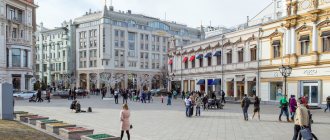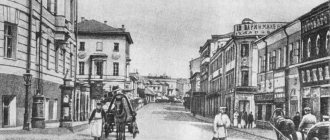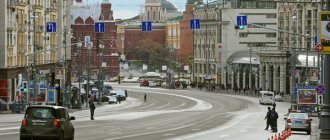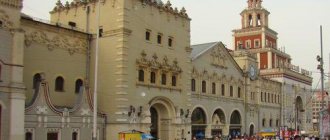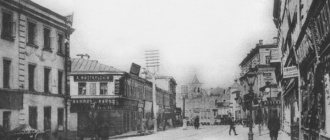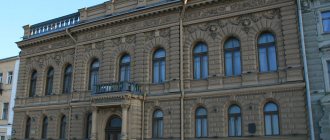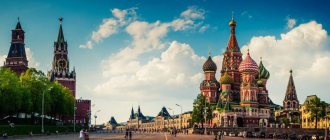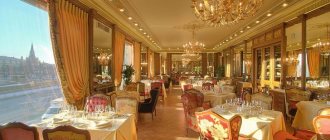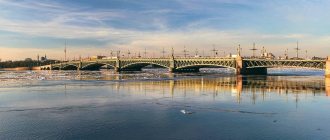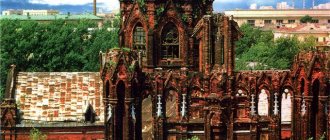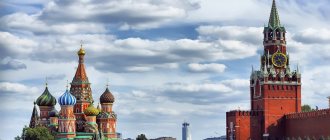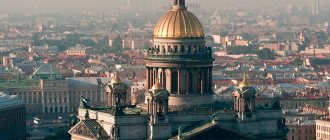History of Povarskaya
In the XIV-XV centuries, Povarskaya Street was a busy route. It was here that the trade road to Veliky Novgorod passed.
During the reign of Russia by Ivan the Terrible, the territory of Povarskaya Sloboda was part of the oprichnina part of the capital extending in these places. It was from here that the sovereign's people went to the main oprichnina cities, known to us as Mozhaisk and Vyazma.
According to the 17th century census, Povarskaya Sloboda consisted of 350 households. In addition to the cooks and attorneys who traditionally lived here, this area was also chosen by other classes by this time: stove makers, archers, printers, chimney sweeps.
At the same time, estates of the Moscow nobility appeared in this area: boyars A.I. Morozova and B.M. Khitrovo.
Povarskaya Street turned into an elite district of Moscow, a place of residence for the aristocracy, at the beginning of the eighteenth century. This was facilitated by the transfer of the capital to St. Petersburg, which was under construction.
Now the Golitsyn, Baryatinsky, Gagarin and Sibirsky families already live here. Here, not far from Borisoglebsky Lane, the courtyard of Peter the Great’s sister, Natalya Alekseevna, was laid out.
In addition to residential buildings, the provincial office was set up on Povarskaya Street in those days.
Over the years, Alexander Pushkin and Mikhail Lermontov, Nikolai Gogol and Pyotr Chaadaev, Taras Shevchenko and the Aksakovs, and the Decembrist Sergei Volkonsky visited or lived on Povarskaya.
During the years of Soviet power, from 1923 to 1994, Povarskaya Street bore the name of the Bolshevik Vorovsky.
In the mid-twentieth century, the Supreme Court building was built on the street; it is noteworthy that the sculpture of Themis, a symbol of justice, installed nearby, does not have a blindfold. The famous Gnesinka, an academy of music and a music school are also located here.
Photo 2. View of Povarskaya Street towards New Arbat
"A city to remember." 636. Povarskaya street - Vorovsky, Themis, Kalmeer
January 19, 2021 Photo project “City in Memory”. 636. Povarskaya street - Vorovsky, Themis, Kalmeer
In ancient times, the Volotsk trade road, leading from Moscow to Veliky Novgorod, ran along the route of what is now Povarskaya Street. Under Ivan the Terrible, the surrounding area was populated by boyars and princes close to the Tsar, as well as palace kitchen servants. The staff of Sytny Dvor consisted of almost 500 people who lived in Povarskaya Sloboda. The names of Povarskaya Street and neighboring lanes - Khlebny, Skatertny, Stolovoy - now remind us of the employees of the royal kitchen.
Throughout the 18th-19th centuries, Povarskaya was one of the most aristocratic streets in Moscow; representatives of many noble families lived here - the Dolgorukovs, Golitsyns, Sheremetevs, Gagarins, Volkonskys, figures of Russian culture and successful merchants.
In the first years of Soviet power, the old regime name was replaced by a new one - Vorovskogo Street. Diplomat Vaclav Vorovsky was shot by an emigrant White Guard in 1923 while on duty in Switzerland. Oddly enough, the killer was acquitted by a Swiss jury, which caused a rupture in diplomatic relations between the USSR and Switzerland. In the Soviet Union, the memory of the deceased diplomat was immortalized in the names of streets, factories, ships, and parks. In Moscow, Vorovskogo Street existed from 1923 to 1993, until it was given back its historical name - Povarskaya.
The monument to Vorovsky was erected in 1924 on Sretenka, where the People's Commissariat of Foreign Affairs of the USSR was located.
The ancient Volotskaya Road (and later Povarskaya Street) began at the Arbat Gate at the intersection with the Smolenskaya Road, but in the early 1960s, due to the construction of Kalinin Avenue, the starting section of Povarskaya Street was lost, now this is noticeable by the numbering of houses, which begins at on the odd side with No. 5, and on the even side with No. 8. However, large-scale construction in the New Arbat area only partially affected Povarskaya Street, which remained a corner of old Moscow with city estates decorated with the coats of arms of former owners, and multi-story apartment buildings.
See old photographs: The unpreserved initial section of Povarskaya Street. 1914: https://pastvu.com/p/1093892
In the old days, Povarskaya Street began from here
Povarskaya Street, 5с1 - Church of St. Simeon the Stylite (Introduction of the Blessed Virgin Mary into the Temple). The five-domed temple with a tented bell tower was built in 1676-1679 at the behest of Tsar Feodor Alekseevich. Count Nikolai Sheremetev and the serf peasant woman Praskovya Zhemchugova-Kovaleva secretly got married there, and the writer Nikolai Gogol came here for communion and confession. Under Soviet rule, religious services were banned, in 1938 the building was transferred to Raipromtrest to house workshops for the deaf and dumb, and during the construction of Kalinin Avenue with high-rise buildings, the existence of the temple was under threat: they say that the historical monument was saved from demolition by the restorer Leonid Antropov, who climbed into the bucket of an excavator. The Temple of Simeon the Stylite was taken under state protection, in 1966-1968 it was restored and adapted into an exhibition hall for the All-Russian Society for Nature Conservation. Exhibitions of feathered and furry pets gave way to exhibitions of paintings and folk art, and in 1990 crosses were installed on the domes, and the temple was returned to believers.
See old photographs: Temple of St. Simeon the Stylite. 1981-1982: https://pastvu.com/p/472726
See old photographs: Corner of Merzlyakovsky Lane and Povarskaya Street. 1912: https://pastvu.com/p/875362
Novy Arbat Street, 2. On the site of the demolished houses in 1967, the building of the House of Communications was built, which housed an automatic telephone exchange, post office, telegraph office, long-distance telephone point and telephone information service 09. Merzlyakovsky Lane was blocked, but for passage and travel in the house an arch is provided. In recent years, the featureless facade of the former House of Communications has been either covered with a media facade or hung with giant banners, and this, according to Moscow customs, is a harbinger of the demolition of the building. It is expected that a hotel will open here.
Povarskaya Street, 8с2 - the Teatralny Dom apartment complex (2017) includes a new building on the site of an apartment building, of which only the façade has been preserved (1893, architect N. Strukov).
Povarskaya Street, 8с1 - the “Theater House” complex, in addition to the above-mentioned detached house, consists of seven different-storey sections, located in a zigzag along Merzlyakovsky and Khlebny lanes, and the facade of the section, stylized as Art Nouveau, faces Povarskaya Street.
Povarskaya Street, 10с1 - apartment building (1910, architect O. Piotrovich) with a facade in the Art Nouveau style with ceramic tiles. The residential building was transferred to the International Community of Writers' Unions and the Commonwealth of Writers' Unions in 1992, and currently the reconstructed building houses a business.
Povarskaya street, 7 - city estate of the Grachevs, main house (1816, architects P. Zykov and G. Kaiser), Embassy of the Kingdom of Norway
Povarskaya Street, 9с1 - the city estate of A. Kazakov - Elizaveta Dunker consists of several buildings, the main house with outbuildings was built at the end of the 18th century, and a hundred years later the ensemble was supplemented by outbuildings, a carriage house and a stable. After the fire of 1812, the wooden house destroyed by fire on a stone semi-basement was rebuilt. The estate changed owners more than once, who rebuilt the house to their liking, decorated the state rooms with decorative panels by Mikhail Vrubel, and equipped a living room with a winter garden. After the revolution, the building was occupied by the Central Correctional Labor Department under the People's Commissariat of Education, and the mansion quickly fell into disrepair, but Vrubel's valuable canvases were transferred to the Museum Department of the Main Science. Since the 1950s, the restored manor house has housed the embassies of first Sudan and then Cyprus.
Povarskaya street, 11с1 - Chernov city estate (XVIII-XIX centuries). The main house went through several reconstructions, in particular, at the beginning of the twentieth century, the architect Mikhail Bugrovsky added a second floor to the building and demolished the outbuildings, and the house acquired its modern four-story appearance in 1932. After the revolution, party officials who moved from Petrograd to the new old capital Moscow moved into the estate, which was named the 6th House of Soviets. A separate office was provided for Joseph Stalin. Since 1974, the building housed the publishing house “Soviet Writer,” which specialized in literary novelties by domestic authors, including translated publications from the languages of the peoples of the USSR. The publishing house annually published up to 500 book titles with a total circulation of over 30 million copies.
Povarskaya street, 11с2 - pre-revolutionary brick building
Povarskaya Street seems quiet and unfussy, but previously there were events here that attracted many townspeople:
See old photographs: A column of tractors driving to the exhibition at the Central Park of Culture and Culture. 1923: https://pastvu.com/p/39880
See old photographs: Demonstration on Vorovskogo Street. 1927: https://pastvu.com/p/469820
See old photos: Mayakovsky's funeral. 1930: https://pastvu.com/p/1197785
Povarskaya Street, 14 - school building (1956). Since 1963, School No. 91 has become an experimental educational institution of the Russian Academy of Education - at different periods psychological experiments were conducted here to study the age-related capabilities of younger schoolchildren, studies of joint activities of students, the first mathematics class for gifted children and a retraining faculty for primary school teachers were opened, specialized training in mathematics was introduced , physics, mathematics and humanities. The educational experiments were based on the system of “developmental education” of Daniil Elkonin and Vasily Davydov, developed since the 1950s. The main goal of the Elkonin-Davydov system is to develop abilities for self-development and self-knowledge through the learning process, that is, schoolchildren are not offered ready-made knowledge, but the opportunity to come to an understanding of phenomena and events themselves. The system was approved by the Ministry of Education, and a large group of scientists received prizes and awards.
Povarskaya Street, 13 - the main house of I. Bludov’s estate was built in the 18th century and has been reconstructed several times since then. At different periods of such a long history, the house housed the Bludov serf theater, the theater school of the directorate of Russian imperial theaters, Nadezhda Muromtseva’s women’s music school, an almshouse, and, under Soviet rule, the Moscow Provincial Court and the Supreme Court of the USSR.
Povarskaya street, 15с1 - the building of the Supreme Court of the USSR was built on the site of the demolished Church of the Rzhev Mother of God (1952-1957, architect B. Leibo).
See old photographs: Near the courthouse during the trial of high-ranking official Yuri Churbanov, Brezhnev's son-in-law. 1988-1989: https://pastvu.com/p/76962
The facade is decorated with a sculpture of the ancient Greek goddess of justice Themis (known as Justitia in Roman mythology). Since the Middle Ages, both divine ladies began to be depicted with a blindfold, which symbolized the impartiality of the court, with scales - a symbol of justice in assessing good and evil, as well as a sword - a symbol of retribution. The author of the sculpture on Povarskaya did not adhere to the canonical image.
A line of apartment buildings lined up along the even side of Povarskaya Street:
Povarskaya Street, 18 - the apartment building of Count K. Khreptovich-Butenev (1902, architect N. Kurdyukov) is known for the first museum in Moscow of the writer Leo Tolstoy, created in 1911 by the writer’s biographer P. Biryukov. The Tolstoy archive occupied eight rented rooms in this house until in 1920 it was moved to mansions on Prechistenka and Khamovniki.
Povarskaya Street, 20 - apartment building of lawyer Joseph Kalmeer (1914, architects V. Dubovskoy and N. Arkhipov). The customer conceived the building as a House of Art and wished to use different artistic styles in interior design, starting with the themes of Ancient Egypt and Ancient Greece. The painting was done by the artist Ignatius Nivinsky. During the Soviet period, the house was nationalized, the tenement apartments were converted into communal housing, and the Mossovet Theater production workshops were located in the basement. One of the famous residents of this house was film actor and director Alexander Kaidanovsky. For a long time, the attic housed the studio of theater artist Boris Messerer, which became a place for informal meetings of the Soviet creative intelligentsia. Andrei Voznesensky, Vladimir Vysotsky, Bulat Okudzhava, Vasily Aksenov, writers, musicians, and artists visited Messerer and his wife, the poetess Bella Akhmadulina.
Since 1986, the basements and part of the apartments have been occupied by theater groups, justifying Calmeier's idea of the House of Art. The first to settle here was the “School of Dramatic Art” of Alexander Vasilyev, then the theater studio and center for theatrical experiments “Open Stage”.
In 2015, during the renovation of its home building, the Taganka Theater rented a stage on Povarskaya. In the photo: Irina Apeksimova, Veniamin Smekhov and others.
Photos: Evgeny Chesnokov
All photo stories of the “City in Memory” project:
Category: Personal blogs. Tags: city for memory, Povarskaya street.
Other publications
Evgeny Chesnokov 02/09/2021 at 00:05
"A city to remember." 639. Stoleshnikov Lane
The origin of the name Stoleshnikov Lane is related to the weaving craft - the word “stoleshnik” in the old days meant “tablecloth”.
Evgeny Chesnokov 01/22/2021 at 00:16
"A city to remember." 638. Povarskaya street - Kekushev, Vesnin, Tolstoy, Mikhalkov
The final stretch of Povarskaya Street presents architectural delights and urban stories for every taste.
Evgeny Chesnokov 01/21/2021 at 18:00
"A city to remember." 637. Povarskaya street - Bunin, Gilardi, Gorky, Gnesiny
The walk along Povarskaya Street continues.
Every house, every estate here is associated with the names of outstanding cultural figures. Evgeny Chesnokov 01/13/2021 at 01:28
"A city to remember." 635. Moscow cinemas. "Ural" - "Yantar"
The audit showed that in recent years, Soviet-built cinemas have suffered heavy losses, but those that still exist continue to fight for viewers.
Evgeny Chesnokov 01/11/2021 at 23:30
"A city to remember." 634. Moscow cinemas. "Sayan" - "Ulaanbaatar"
At the Sputnik cinema in Lefortovo, viewers can not only watch new films, but also visit an exhibition of rare film projection equipment.
Evgeny Chesnokov 01/10/2021 at 22:48
"A city to remember." 633. Moscow cinemas. "Polar" - "Saturn"
The most famous Moscow cinema was called "Russia", it opened in 1961 and retained the original sign on the facade.
The hall is currently rented by the Musical Theatre. Evgeny Chesnokov 01/09/2021 at 23:19
"A city to remember." 632. Moscow cinemas. "Eagle" - "Flight"
As the guidebook “Around Moscow” wrote in 1954, “in the fifth five-year plan it is planned to build 27 new well-equipped cinemas with 12,500 seats in Moscow.”
Evgeny Chesnokov 01/08/2021 at 12:33
"A city to remember." 631. Moscow cinemas. "Ladoga" - "Orbit"
The maintenance and repair of cinemas required serious expenses and cinema administrations had no choice but to rent out the premises.
Evgeny Chesnokov 01/07/2021 at 17:50
"A city to remember." 630. Moscow cinemas. "Zvezdny" - "Kuntsevo"
The third part of the review of Soviet cinemas included a unique technical attraction - the Circular Cinema Panorama, which opened on June 16, 1959 at VDNKh.
Evgeniy Chesnokov 01/06/2021 at 22:30
"A city to remember." 629. Moscow cinemas. "Volga" - "Zvezda"
The Moskino chain operates successfully in Soviet-built buildings, saving 13 large and small cinemas from closure.
Evgeniy Chesnokov 01/05/2021 at 00:53
"A city to remember." 628. Moscow cinemas. "Avangard" - "Vladivostok"
“A City in Memory” made inquiries about 138 cinemas that operated in Moscow in the 1970s and 1980s.
Evgeny Chesnokov 12/23/2020 at 02:08
"A city to remember." 627. Pebbles and “Moscow City”
Kamushki is the name given to the Presnensky residential microdistrict, located almost on the very bank of the Moscow River on the site of the old Dorogomilovsky quarries.
Evgeny Chesnokov 09.11.2020 at 22:51
"A city to remember." 625. Krasnokazarmennaya street
Another Lefortovo story is dedicated not to the times of Peter the Great or Catherine, but mainly to Soviet science and students.
Evgeniy Chesnokov 08.11.2020 at 13:34
"A city to remember." 624. Rogozhskaya Sloboda
The Rogozhskaya Sloboda owes its origins to Empress Catherine II, who allocated land to the Old Believers in gratitude for their contribution to the fight against the plague epidemic.
Evgeniy Chesnokov 07.11.2020 at 12:29
"A city to remember." 623. Stalinka on Pervomaiskaya Street
The surrounding area of the village of Izmailovo became part of the capital in 1935 as part of a new district - Stalinsky.
Evgeny Chesnokov 10.15.2020 at 23:12
"A city to remember." 622. Northern River Station 2020
The main decoration of the Moscow-Volga canal was the Northern River Station, built according to the design of architects Alexei Rukhlyadev and Vladimir Krinsky.
